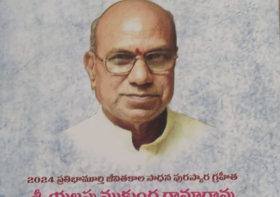Interview with Canadian author Drew Hayden Taylor – Part 2

Interviewed by: Sriram Chadalavada and Sowmya V.B.
*************************
Drew Hayden Taylor is a famous First Nations (indigenous people of Canada) author who has a very diverse body of work with a recent book of science fiction short stories called “Take us to your Chief” written from a unique Aboriginal perspective and a melange of pathos and humor. We interviewed him on behalf of pustakam.net and this is the transcript of our conversation. Part 1 can be seen here.
[Continued from Part 1]
Sowmya: Are there writings published in indigenous languages now?
DHT: There are some, not a lot. There are 50+ languages spoken in Canada, many are dying. It is predicted that there will be only 3 left (Inuit, Cree, Ojibwe) in 30 years.
Sowmya: Oh, Inuit and Cree communities are also active in developing software tools and other digital applications for their languages.
DHT: Yes
Sowmya: Do you know why Inuit and Cree are more active with such things?
DHT: They are more Northern, and they are more isolated. They are also more in population – so there are more people to talk to. There is a place called Moravian Town here in Ontario, where there are the Delaware people. There are only two people left that speak their language now.
Sowmya: Are there efforts to document such languages?
DHT: Yes, there are projects to build dictionaries, to record native speakers, and there are also some projects to come up with new words – words such as satellite, cellphone etc, which do not exist in these languages. They go and speak to the native speakers of these languages, describe these objects, and create words for them.
Sowmya: One of your stories has a radio station in a native language.
DHT: Mohawk language, yes.
Sriram: Are there any such radio stations in real life?
DHT: There used to be. Every 10 years a new radio station pops up. After sometime, funding disappears. APTN (Aboriginal Peoples Television Network) plans to open radio stations in a few big cities – I don’t know how far they are with it now. I think it started.
Sowmya: Do you know of anybody writing in Indigenous languages?
DHT: Tomson Highway is trilingual in English, Cree and French. He keeps going back and forth between them. But I don’t see anyone writing exclusively in a Indigenous language – it is hard to make money out of it. Sometimes people get a grant or fellowship to do it. But I don’t know specifically.
Sowmya: What about the chances of translations between different languages and English?
DHT: Well, I don’t a lot of written work in Indigenous languages in general (as they have oral tradition) but there are some sponsored grants to translate from English to indigenous languages. Banff center (Banff International Literary Translation Centre) has workshops on translation involving first nations languages, sometimes.
Sowmya: Which indigenous writers do you enjoy reading the most?
DHT: I am a big Tom King (Thomas King) fan. He is my hero. I want to grow up to be Tom King. I used to like some Sherman Alexie, Tomson doesn’t write a lot anymore, but I grew up reading Tomson. Because I get asked to write about literature, I also read a lot of world literature, native literature and others. I don’t read as much first nations literature as I should. There is so much coming out.
Sowmya: Have you read anything by indigenous writers from other cultures outside North America?
DHT: I did some field work in Australia, and I went to New Zealand, where I read some of the indigenous writers. I also recently came into contact with someone from Brazil, who is involved in developing indigenous literature there based on Canadian lndigenous literature.
Sowmya: I am done with my questions. I am talking all the time. Why don’t you ask about some?
Sriram: Okay, let me ask a few questions about the book (“Take us to your chief”). How did the mainstream audience react to this book?
DHT: Very well. I think I told this – I went to two publishers before this, and they turned it down – natives and science fiction sounded too weird, like appled and oranges. I then sent into one of the publishers that previously published my non-fiction and they loved it. The response for the book has been overwhelming. This was so much fun to write. I enjoyed writing it. This is stuff I have been storing up for 20-30 years, ever since I was a kid. The response was just fabulous. I am very very delighted.
Sowmya: Can we expect more science fiction stories in future?
DHT: Yes. I wrote a collection of stories, not science fiction, called “Fearless Warriors” in the past. I am very proud of that. I am interested in doing another collection of stories – which will be a combination of both kinds of stories. Some of the weirder stuff, some of the believable, realistic stuff – I want to couple them together in my third collection of short stories.
Sriram: Do you have a name for this collection?
DHT: Not yet.
Sriram: How do you get ideas for all these stories?
DHT: They are stocked up in me. Reviewers used the word “tropes” – these are typical science fiction themes – time travel, aliens, artificial intelligence – all these are common issues in science fiction. I just wanted to take all these familiar themes, and put them through an indigenous filter.
DHT: I wanted to write a story on AI, and I wrote it. That story does not have indigenous characters – infact, they are all white characters, but there is a talk about indigenous philosophy.
Sriram: Right.
DHT: Actually, where would that story fit in your culture? The point of AI having a spirit? In Islam. Christianity etc – they don’t have spirits. In the native culture, everything has a spirit.
Sriram: It is the same for us. All sorts of things have spirits.
DHT: A lot of people had an affinity for the story “Lost in Space”
Sriram: That is me. I will tell you why I liked that story – it is rare to read science fiction stories with an element of pathos.
DHT: Ya, Ya. A lot of things about native people has to do with mother earth, the earth we are walking on. So, is it possible to be native up in Space? – that was what I was exploring in that. But, nothing really happens in that story. It is just inner musings.
Sriram: That is the best part.
DHT: Yes it is, but, see we spoke about filmic versions, this story makes a very bad television show because, nothing happens. This guy is sitting in the spaceship, remembering his grand father.
Sriram: Take that movie 2001: A Space Odyssey. Nothing much happens in that movie either. But it became a classic. So, we never know.
DHT: I don’t think I mentioned this in the book – about the cover.
Sriram: Yes?
DHT: The publisher obtained the cover from a west coast artist Andy Everson. You can tell it is a west coast design. I loved it. It is a great cover for the book. I remember looking at it and saying to the publisher- “none of my stories deal with a toy robot, or with the west coast. Is that a problem?”. “Not really” he said. It bothered me. “Do you think we should put a story in there about the picture?” – “Sure, that would be great”. So, that is the last story I wrote for the collection. “Mr Gizmo”
Sowmya: Yes, I was about to mention that. I thought the cover page is about that story.
DHT: Yes, at that time I was a writer-in-resident at Wilfred Laurier University in Kitchener-Waterloo, after banging my head against the wall, I came up with an idea after 3 days and wrote it.
At that time, I was also teaching some classes at the university about writing. I mentioned about this struggle with one of my colleagues there. She asked me – “do you mind if I share this story with my students in the writing class?” I said: “Sure, why not?”. She said – “Lot of my students are young, idealist writers. They believe they should not write anything until they are inspired, until the muses whisper something in their years, and they shouldn’t be forced to write something with a deadline.” I told her to tell them: “The best inspiration is a mortgage”. Writing is a job. It is a fun job. But it is still a job.
Sriram: So, the story “Take us to your chief” .. the humor in that story… how does one write good humor?
DHT: I cannot really explain how to write humor. First thing is – never try to be funny, because it always sounds like you are trying to be funny. It has to be organic. It has to spring from the character or the situation. Sometimes there is a funny situation that makes the characters look funny, sometimes there are funny characters that make the situation look funny. I wrote a comedy play called “Bootlegger blues” about a 58 year old good christian Ojibwe woman, who through a series of circumstances finds herself in possession of 143 cases of beer, which she has to bootleg in order to do a fundraiser for the church. When you have a premise like that, it is easy to write a funny play. In this story, “take us to your chief”… I know many native people who are just like silent, they don’t like speaking in English. It is such a funny idea to change over the awe-inspiring vision of a spaceship landing, how this is will change the world etc… and these guys really don’t care. They just want their beer. But they end up being ambassadors.
Sriram: Very nicely done.
DHT: Thank you.
Sriram: Okay, as a writer, you’ve been writing for quite some time. How did the arrival of ebooks, audio books etc change things for you?
DHT: Some of my books are also sold as ebooks, there was one audio book – but it doesn’t really change anything. It seems like the ebook sales have also plateaued, everybody thought they will take over the books, but many people still like the feel of a book in their hand. I understand the appeal of having a kindle especially when I am traveling around carrying large books, but I still like to read books.
Well, that was a fun conversation with an entertaining DHT. On behalf of pustakam.net, we thank the author and playwright. We hope to see more interesting books from him in the future.




Leave a Reply